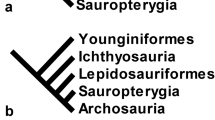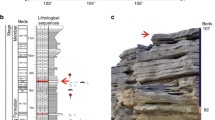Abstract
The coelacanth Latimeria chalumnae is the only living relic of a fossil group of crossopterygian lobe-finned fish1–4. We describe observations of its locomotion in a natural environment using six individuals observed from the research submersible Geo in the Indian Ocean at a depth of between 117 and 198 m. Past speculation on the pattern of locomotion has included crawling with the paired fins on the rocky ocean bottom, stalking like a large piscivorous grouper, or even fast swimming in open water4–6. Our observations show L. chalumnae to be a nocturnal piscivorous drift-hunter, moving very slowly in up- or downwelling currents, while paired fins stabilize and correct the drift motion. Paired and unpaired lobed fins are able to generate thrust. Fast starts are performed with the large caudal fin. Paired fins were not used for locomotion along the bottom. They alternate synchronously in a pattern common in tetrapod locomotion.
Similar content being viewed by others
References
Smith, J. L. B. Trans. R. Soc. S. Afr. 28, 1–106 (1939).
Jarvik, E. in Théories de l' évolution des vertébres recousiderées à la lumièere des récentes découvertes sur les vertébres inferieurs (Masson, Paris, 1960).
Thomson, K. S. J. Paleont. 41, 660–674 (1967).
Wahlert, G. V. Latimeria und die Geschichte der Wirbeltiere (Gustav Fischer, Stuttgart, 1968).
Millot, J. & Anthony, J. Anatomie de Latimeria chalumnae Tome I: Squelette et Muscles (CNRS, Paris, 1958).
McCosker, J. E. Occ. Pap. Calif. Acad. Science 134, 17–23 (1979).
Millot, J. Nature 175, 326 (1955).
Stévens, J. A. Life 61, 4 (1966).
Locket, N. A. & Griffith, R. W. Nature 237, 175 (1972).
Bemis, W. E. & Hethering, T. E. Copeia 1982(2), 467–471 (1982).
Webb, P. W. J. exp. Biol. 74, 211–226 (1978).
Voβ, W. Fortschr. Ber. VDI-Z (Reihe 12) 42, 1–192 (1982).
Wickler, W. Encycl. Cinematogr. Göttingen, Film E 151 (1962).
Wickler, W. Verhalten und Umwelt (Hoffman and Campe, Hamburg, 1972).
Westoll, T. S. Biol. Rev. 18, 78–98 (1943).
Szarski, H. Q. Rev. Biol. 37, 189–241 (1962).
Schaefer, D. Am. Zool. 5, 267–276 (1965).
Thomson, K. S. Biol. Rev. 44, 91–154 (1969).
Author information
Authors and Affiliations
Rights and permissions
About this article
Cite this article
Fricke, H., Reinicke, O., Hofer, H. et al. Locomotion of the coelacanth Latimeria chalumnae in its natural environment. Nature 329, 331–333 (1987). https://doi.org/10.1038/329331a0
Received:
Accepted:
Issue Date:
DOI: https://doi.org/10.1038/329331a0
- Springer Nature Limited
This article is cited by
-
Buoyancy and hydrostatic balance in a West Indian Ocean coelacanth Latimeria chalumnae
BMC Biology (2022)
-
The coelacanth rostral organ is a unique low-resolution electro-detector that facilitates the feeding strike
Scientific Reports (2015)
-
The population biology of the living coelacanth studied over 21 years
Marine Biology (2011)
-
Home range and migrations of the living coelacanth Latimeria chalumnae
Marine Biology (1994)
-
Locomotion, fin coordination and body form of the living coelacanth Latimeria chalumnae
Environmental Biology of Fishes (1992)





